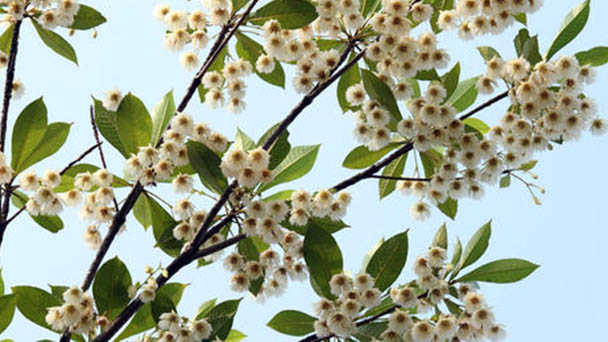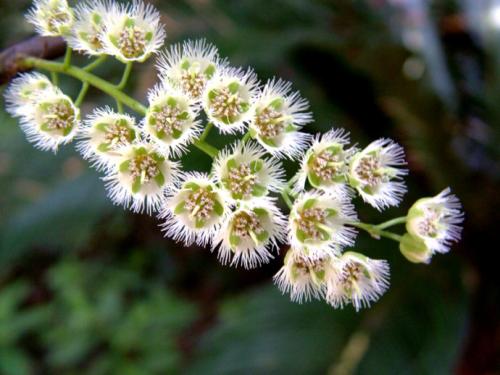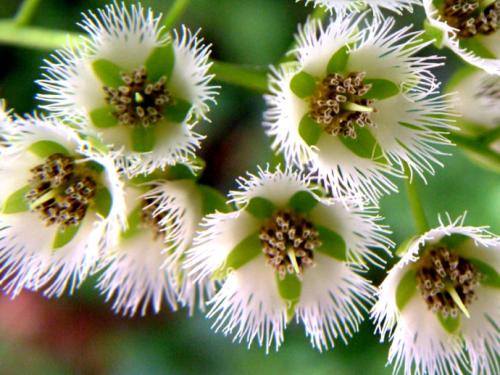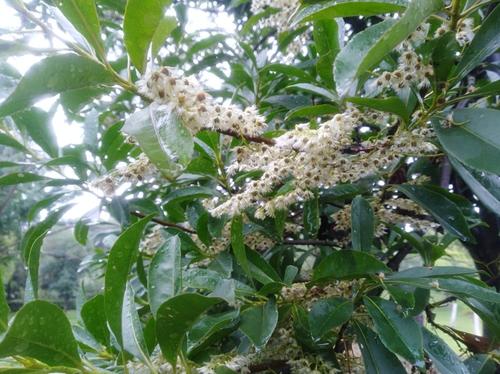Elaeocarpus sylvestris (woodland elaeocarpus) profile
Written by Maggie
Mar 18 2021

Elaeocarpus sylvestris (woodland elaeocarpus) is an evergreen tree, up to 15 m tall, with leathery, lanceolate or oblanceolate leaves and edges with small obtuse teeth; Petiole hirsute at first, bald when fruity. Racemes are more than born in axils of leaves, racemes slender, white flowers, sepals lanceolate, petals obovate, anther apex without appendage; Drupe is elliptic, exocarp glabrous, endocarp firm bony.
Elaeocarpus sylvestris, a fast-growing evergreen tree with good material, good adaptability and few pests and diseases. It is an excellent variety for courtyard viewing and afforestation. elaeocarpus sylvestris is distributed in Guangxi, Guangdong, Jiangxi, Fujian, Taiwan, Zhejiang;Vietnam, low mountain valley forest. The oil can be used as soap and lubricating oil; Dye can be made from bark.
Elaeocarpus sylvestris picture

Morphological characteristics of Elaeocarpus sylvestris
Branch
Elaeocarpus sylvestris are evergreen trees, 5-15 m tall; Twigs and terminal buds are slightly hairy at first, and soon become bald and clean, after dry black brown.
Leaf
Elaeocarpus sylvestris leaves are leathery, lanceolate or oblanceolate, 7-12 cm long, 2-3.5 cm wide, dark green above, shine after being dried, the bald net glabrous, or glabrous when young, apex acuminate, tip obtuse, base cuneate, decurrent, lateral veins 7-9 pairs, above is not very obvious, in the following slightly protuberant, net veins on both sides are not obvious, the edge has little obtuse teeth; Petiole is 1 cm long, slightly hairy at first, bare when fruity.
Flowers
The racemes of elaeocarpus sylvestris, often in axils of leaves, 4 -- 10 cm long, with slender, hirsute racemes; Pedicle is 4-5 mm long; flowers are white, sepals lanceolate, 5.5 x 1.5 mm, apex acute, puberulent on both sides; Petals are obovate, as long as sepals, upper half lacerated, lobes 14-16, lateral glabrous, medial near base hairy; Elaeocarpus sylvestris has 25-30 stamens, 3 mm long, filaments very short, anther apical without appendage; Disk is 5-lobed, hairy;Ovary 3-loculed, style 3.5 mm long, ovules 2 per locule.
Fruit
The drupes of Elaeocarpus sylvestris are elliptic, 2 -- 2.5 cm long and 1.3 -- 2 cm wide, exocarp glabrous, endocarp firm, surface with many grooves, 1 locule, 1 seed, 1.5 cm long.
Ecological habits of Elaeocarpus sylvestris
Elaeocarpus sylvestris prefers warm and humid environments and is slightly less hardy to cold. Elaeocarpus sylvestris is slightly shade-resistant, well-developed roots, strong germination, resistant to pruning. Elaeocarpus sylvestris likes well-drained, moist, fertile acid soil. Elaeocarpus sylvestris is suitable for acidic yellow soil and red-yellow soil mountainous area, if planted in plain, must be well-drained, medium to the fast growth rate. Elaeocarpus sylvestris has strong resistance to sulfur dioxide.
How to grow and care for Elaeocarpus sylvestris
Fertilization
Seedling growth early, every half a month to apply the concentration of 3%-5% rarefied human excrement. After mid May, 1% superphosphate or 0.2% urea solution can be used.
Weeding
Alternate spray of 50% acetochlor 1200 ml/ha and 12.5 ml/ha can be used for 45 days between 600 ml/ha.
Water
In the plum rain season, drainage should be done;Irrigation should be done well in the dry season.
Thinning
During the peak growth period, thinning seedlings of Elaeocarpus sylvestris should be done in stages and in batches, seedlings should be fixed in late July, 30-40 plants/square meter should be reserved, and nitrogen fertilizer should be stopped in the first half month of the Start of Autumn. In autumn, it can spray 0.3-0.5% potassium dihydrogen phosphate solution and 0.2% boron sand solution every 10 days. Elaeocarpus sylvestris can be sprayed alternately 2 times to 3 times, so as to improve the lignification of seedlings. Generally a year seedlings can grow to about 50 centimeters high.
The way Elaeocarpus sylvestris propagates
Elaeocarpus sylvestris is mainly seeded and reproduces. The flowering period is in summer, the fruiting period is in autumn, and the drupes are conical and dark purple. Generally, seeds are sown after seed collection. Seeds can also be deposited with wet sand until the next spring sowing. Seedling period can be a few times in summer topdressing thin fertilizer, seedlings will be planted in the second spring. Small seedlings should be transplanted with soil, large seedlings should be transplanted with soil balls, and appropriate sparse part of the branches and leaves, the survival rate after transplanting is very high.
Seed propagation
Seed collection and seed treatment Seed collection mother trees should be more than 15 days old, robust growth and free of pests and diseases of the plant. When the fruit turns from green to dark green in autumn, the drupes are ripe and seeds should be harvested in time. After the fruit can be stacked in the shade or soaked in water for 1-2 hours, until the outer pericarp is softened, rubbing and washing, and then rinsed with water, indoor spread out to dry in time after sand storage (seeds by all means avoid insolation, it is not suitable for long-term dehydration and dry storage). Seeds of Elaeocarpus sylvestris are mostly deeply dormant. Seeds stored in wet sand at low temperature can significantly increase the germination rate (up to more than 60%).
Cutting propagation
In early summer, cut cuttings of Elaeocarpus sylvestris from current semi-lignified shoots, 10-12 cm long, cut off the lower leaves, keep 2-3 leaves on the upper part, cut off half of each leaf, soak the base with 100 mg/kg NAA or 50 mg/kg ABT root powder solution for 2-4 hours. Vermiculite or river sand as the substrate, after inserted, pour enough water, with plastic film arch shed closed moisture, shade cooling. Generally do not need to spray water management, spray 0.1% potassium permanganate every other week to prevent decay. Where conditions permit, all-light automatic spray can be used for seedling cultivation. The experimental results showed that the seedling was raised by this device, and the root began about 20 days after the cutting, and the survival rate of the cutting could reach more than 90%.
Disease control & pest of Elaeocarpus sylvestris
Disease control
Burning disease
Characteristics: Elaeocarpus sylvestris is susceptible to sunburn due to its thin bark. The bark of sunburn place is injured, the xylem degree is different to crack, rot, when blowing gale many trees break off in this place.
Prevention and control methods:
1. Maintain the appropriate height of the dry. In the summer from 11 a.m. to 3 p.m., the canopy can shade its trunk to prevent the trunk from being subjected to strong direct sunlight in the midsummer season.
2. As a landscaped tree planting density is appropriate, between the crown of the tree can mutually side shade trunk;
3. When the crown is unable to shade the trunk, wrap it with straw ropes down to the lowest branches to protect it from direct light.
Leaf blight
Characteristics: Mainly damage leaves of Elaeocarpus sylvestris, causing leaf spots and leaf shrinkage.
Prevention and control method: use 50% tobujin wettable powder 500-600 times liquid, or 75% chlorothalonil wettable powder 500 times liquid, or 50% dicunazole (yekulin) powder 1000 times liquid, or 10% zhukujing wettable powder 1000 times liquid. In order to enhance the adhesion of the solution on the leaves, 0.1% washing powder can be added into the solution.
Damping-off
Characteristics: Bacteria invaded the Elaeocarpus sylvestris root and stem base of the seedlings from the surface soil, and the infected parts of the seedlings were constricted and constricted, turning black and brown. The infected seedlings often fell down from the soil surface, resulting in cataplexy (the so-called cataplexy). If the seedling organization has been lignified, the disease seedling often does not lie down and the performance is to stand dry symptoms. When the soil layer is wet, the disease area often produces a pink mold layer.
Prevention and control methods:
1. The early onset of seedlings with 70% methyl tobuzine wettable powder 1000 times solution, dixone 1000 times solution irrigation, can play a role in sterilization and seedling preservation.
Please remove and handle the diseased plant in time to reduce the source of infection.
It is best to disinfect the soil with formalin before sowing or planting by applying 50 liters of formalin to the soil with 16 to 24 jin of water per square meter or 15 kilograms of ferrous sulfate per mu mixed with fine sand.

Pest control
Red candle pest
Characteristics: Elaeocarpus sylvestris uses nymphs and female adults to stink and suck SAP from branches and leaves of Elaeocarpus sylvestris. Excretion of honey dew often induces coal stain disease, weakens tree strength, and causes branches to die in severe cases.
Prevention and control methods:
1. Attention to ventilation and light between plants can inhibit the flourishing of insect pests.
The combination of pruning, cutting off insect branches and burning.
In the middle and late June in the early stage of the hatching nymphs with insecticide spray prevention, can be used 10% imidacloprid powder 1000-1500 times liquid;0.3% hyperosmotic abamectin emulsion 1500-2000 times liquid; Kill 1500 times faster liquid;4.5% beta-cypermethrin emulsion 2000 times liquid spray, must be alternately, and every 7-10 days spray, the insect base can be well controlled. The Elaeocarpus sylvestris should be perforated and injected with 30% acetamidophos 3 times solution. The solution should not drop at all.
Tea bag moth
Characteristics: the leaves often eat light, branches die, forest growth weak, affect the landscape, reduce the ecological effect.
Prevention and control methods:
1. Manning measures: artificial removal of the protective bag, for the insect number of trees, should be timely pruning, cutting dead branches, insect branches and leaves, concentrated burning, can effectively reduce the density of the insect.
⒉ Pharmaceutical spray: 0.3% hyperosmotic abamectin emulsion 1500-2000 times liquid spray; BT wettable powder 500 times spray;4.5% beta-cypermethrin emulsion 1000 times liquid spray; 3.2% insect-killing emulsion 1000 times liquid spray.
Protection of natural enemies: Parasitic flies and Beauveria bassiana are two parasitic natural enemies of tea bag moth larvae, which should be carefully protected or utilized.
Mole cricket and ground tiger
Characteristics: both adults and nymphs (wingless insects) have developed chewing mouthparts and a variety of feeding habits. They can drill into the soil and harm the young roots and rhizomes of flowers and trees, and steal the seeds of flowers.
Prevention method: DDVP solution can be used on the bed surface with a bamboo stick hole irrigation.
The distribution of Elaeocarpus sylvestris
Elaeocarpus sylvestris is native to southern China and distributed in Zhejiang, Jiangxi, Fujian, Taiwan, Hunan, Guangdong, Guangxi and southern Guizhou. Most of them are found in mountain forests below 1000m above sea level.
Elaeocarpus sylvestris is native to south of the middle and lower reaches of the Yangtze River to southern China, and is also found in Vietnam.
Elaeocarpus sylvestris uses
Elaeocarpus sylvestris landscaping purposes
Elaeocarpus sylvestris is a kind of thick leaves, after frost, some of the leaves turn red, red and green, very beautiful, suitable for lawns, sloping land, forest edge, front of the court, intersection, but also can be planted as a background tree for other flowers and trees.
Economic purpose
Bark: Used as a dye.
Wood: for the cultivation of mushroom good wood.
Fruit: Edible.
Seed Oil: Used as soap and lubricating oil.
Root: hot and warm, the root can dissipate blood stasis and reduce swelling, and treat bruises, injuries and blood stasis.
Ecological greening
The most obvious feature of Elaeocarpus sylvestris is the red leaves hanging from the treetops before their leaves fall off. They drift slowly in the wind, moving like a school of small fish. Elaeocarpus sylvestris is the plant to stop and admire when looking at the leaves. Material can be used as a general appliance, seed oil can be used as a lubricant, bark can also be used as a dye, is very suitable for the home garden to add scenery, greening or ornamental trees.
With the development of urban construction, improving the environment, greening and beautification has become the goal of people's pursuit. In the urban greening, in order to choose the tree species with high survival rate, low cost and good benefit, it is necessary to make full use of the excellent local tree species, which is because the local tree species have strong resistance to adversity and adaptability to water and soil. Elaeocarpus sylvestris is one of the best native tree species in southern Fujian.
From autumn to winter to early spring, some leaves turn crimson and green, which are bright and pleasing to the eye. In addition, they grow rapidly and are easy to propagate and transplant. Therefore, Elaeocarpus sylvestris are widely planted as street trees and landscape trees in the south of the middle and lower reaches of the Yangtze River.
In late autumn, Elaeocarpus sylvestris has some leaves that formed in the spring of the same year. Under the influence of low temperature frost, chlorophyll is converted to anthocyanins, and the green of the leaves is obscured by the red of anthocyanins, giving them a vivid red color. Landscrubbers call this bright, deep red "crimson". Among the many green leaves, there are flowers that look like red. In early winter, among the withered and yellow leaves of other plants, this "crimson" and dark green contrast is very dazzling. Elaeocarpus sylvestris has ornamental value.
Trees
Street trees are trees lined on both sides of the road, which mainly play the role of shading, greening, beautifying and regulating temperature and humidity. Generally, large leaves and thick branches and leaves are required to block the sunlight on the sidewalk. Such as camphor trees, magnolia magnolia and French parasol trees, which are widely planted, have this function. Elaeocarpus sylvestris, on the other hand, has low-branching, brightly colored leaves, compact branches and is suitable for green hedgerows, making it a more advantageous street tree.
Reduce the noise
Elaeocarpus sylvestris has been proved by practice that the ecological barrier constructed by Elaeocarpus sylvestris at 8m away from the exterior wall of the house, with the height ≥10m, the length ≥150m, the thickness ≥ 2m, and the distance from the pollution source about 12ill, has obvious effect on preventing dirt pollution and reducing or avoiding harm.

Latest Updated
- Benefits of Bugleweed - 7 Science-backed Health Benefits
- Bugleweed Dangers & Side Effects - Is It Poisonous?
- How to Plant Evergreen Trees - What You Should Know
- When to Plant Evergreens - Grow Guide for Evergreen Trees
- 12 Wonderful Evergreen Shrubs for Your Garden
- 12 Popular Evergreen Plants with Pictures for Beginners
- When And How To Prune A Lilac Bush Like a Pro
- How to Grow & Care for Lilac Vine (Hardenbergia Violacea)
- Japanese Lilac Tree (Syringa Reticulata) Care & Propagation Guide
- Shumard Oak Pros and Cons - What to Know
Popular Articles
- Winter maintenance of Antirrhinum Majus
- How to Grow Terminalia Mantaly Tree
- How to Grow and Care for Crossostephium Chinense
- How to grow Antirrhinum Majus in spring
- Peristeria Elata (Dove Orchid) Profile: Info & Care Guide
- Underwatered Snake Plant (Sansevieria Trifasciata) - Signs And How To Fix
- How to Care for Brazilian Jasmine Plant (Mandevilla Sanderi)
- How to Grow & Care for Graptopetalum Purple Delight in Summer
- Rosa Chinensis (China Rose): Plant Growing & Care Tips
- How to Care for Baby Sun Rose (Aptenia Cordifolia)